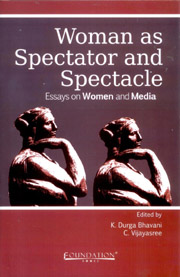Book contents
- Frontmatter
- Contents
- Notes on Contributors
- Preface
- Introduction
- Part I Media and Gender (In)Justice
- Part II Framing Women
- 7 Images of Women in Indian Soap Operas
- 8 “People Said I Created Pornography”: Sexuality, the Gaze and Rituparno Ghosh
- 9 Women's Issues in Telugu Films: Limits of Social Reform
- 10 A Case Study of the Reel-life ‘Wimin’ in Fire and Girlfriend: Fruition to Miso Phallicism from mere Feminism
- 11 Gender at Cyberspace: Who's Online?
12 - Women in Media: The Politics of Representation
from Part II - Framing Women
Published online by Cambridge University Press: 05 November 2011
- Frontmatter
- Contents
- Notes on Contributors
- Preface
- Introduction
- Part I Media and Gender (In)Justice
- Part II Framing Women
- 7 Images of Women in Indian Soap Operas
- 8 “People Said I Created Pornography”: Sexuality, the Gaze and Rituparno Ghosh
- 9 Women's Issues in Telugu Films: Limits of Social Reform
- 10 A Case Study of the Reel-life ‘Wimin’ in Fire and Girlfriend: Fruition to Miso Phallicism from mere Feminism
- 11 Gender at Cyberspace: Who's Online?
Summary
In this article, I will be focusing on the representation of women in crimestories in mainstream English newspapers and to what extent these are reflective of a deeper social position which itself is constituted of various contradictory attitudes; neo-conservative as well as radical.
The cases of Jessica Lal and Priyadarshini Mattoo have brought to the fore, discussions about the representation of women in media reports. The crimes committed against these women are not just rape and/or murder, but also delayed justice and media reporting. Even at its most sympathetic, the mainstream English print media has been blind and insensitive to certain gender issues. It does not understand for example that bringing crime against women to public notice is as important as the ideological/theoretical underpinning of the exercise. Through my paper I would like to explore this with special reference to the Lal and Mattoo cases. I would also like to look at how continued media focus may inadvertently help in perpetuating a discourse of oppression, by deflecting attention from the real issues to peripheral ones, which in turn may indirectly support a conservative approach to gender matters.
The story of the Jessica Lal case goes as far back as eight years. She was shot dead on April 29, 1999. The media has been congratulated for whipping up public interest in this case and mobilizing popular support to reopen the case.
- Type
- Chapter
- Information
- Woman as Spectator and SpectacleEssays on Women and Media, pp. 101 - 106Publisher: Foundation BooksPrint publication year: 2010



